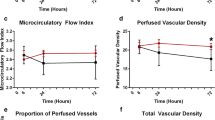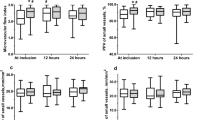Abstract
Objective
To investigate the correlation between different Chinese medicine (CM) syndromes and variations in microcirculation in septic shock patients.
Methods
seventy Septic shock patients were divided into four groups: heat damaging qi-yin group (HDQY, 23 cases); yin exhaustion and yang collapse group (YEYC, 26 cases); excessive heat in Fu organ group (EHFO, 10 cases); and heat damaging nutrient-blood group (HDNB, 11 cases). Sublingual microcirculation parameters were observed by sidestream dark-field (SDF) imaging and scored by Acute Physiology and Chronic Health Evaluation II (APACHE II) and the Sequential Organ Failure Assessment (SOFA), and parameters of microcirculation perfusion variations and prognoses were analyzed.
Results
Compared with those with qi-yin heat damage, perfused vessel density (PVD) in other groups decreased dramatically (P<0.05), and APACHE II scores increased significantly (P<0.05). In addition, the recovery time was prolonged substantially (P<0.05), and the mixed venous oxygen saturation (SVO2) decreased (P<0.05). Blood lactic acid increased significantly (P<0.05), and the mixed SVO decreased (P<0.05), in the YEYC group. Compared with the thermal injury camp blood group, sublingual microcirculation parameter variations showed no obvious difference in the YEYC and EHFO groups (P>0.05). There were significant positive correlations between CM syndromes and APACHE II scoring in different groups (r=0.512, P<0.05). There were negative correlations between PVD and APACHE II scoring (r=−0.378, P=0.043), the proportion of perfused vessels (PPV) and APACHE II scoring (r=−0.472, P=0.008), as well as between the microvascular flow index (MFI) and APACHE II scoring (r=−0.424, P=0.023) in different patients.
Conclusion
Sublingual microcirculation may serve as a clinical diagnostic parameter of the patient condition, as well as being a prognostic indicator.
Similar content being viewed by others
References
Otero RM, Nguyen HB, Huang DT, Gaieski DF, Goyal M, Gunnerson KJ, et al. Early goal-directed therapy in severe sepsis and septic shock revisited: concepts, controversies, and contemporary findings. Chest 2006;130:1579–1595.
Bateman RM, Sharpe MD, Ellis CG. Bench-to-bedside review: microvascular dysfunction in sepsis—hemodynamics, oxygen transport, and nitric oxide. Crit Care 2003;7:359–373.
Groner W, Winkelman JW, Harris AG, Ince C, Bouma GJ, Messmer K, et al. Orthogonal polarization spectral imaging: a new method for study of the microcirculation. Nat Med 1999;5:1209–1212.
Trzeciak S, Dellinger RP, Parrillo JE, Guglielmi M, Bajaj J, Abate NL, et al. Early microcirculatory perfusion derangements in patients with severe sepsis and septic shock: relationship to hemodynamics, oxygen transport, and survival. Ann Emerg Med 2007;49:88–98,98.e1–e2.
Dubin A, Edul VS, Pozo MO, Murias G, Canullán CM, Martins EF, et al. Persistent villi hypoperfusion explains intramucosal acidosis in sheep endotoxemia. Crit Care Med 2008;36:535–542.
Boerma EC, Voort PHJ, Spronk PE, Ince C. Relationship between sublingual and intestinal microcirculatory perfusion in patients with abdominal sepsis. Crit Care Med 2007;35:1055–1060.
De Backer D, Creteur J, Preiser JC, Dubois MJ, Vincent JL. Microvascular blood flow is altered in patients with sepsis. Am J Respir Crit Care Med 2002;166:98–104.
Mathura KR, Vollebregt KC, Boer K, De Graaff JC, Ubbink DT, Ince C. Comparison of OPS imaging and conventional capillary microscopy to study the human microcirculation. J Appl Physiol 2001;91:74–78.
Goedhart PT, Khalilzada M, Bezemer R, Merza J, Ince C. Sidestream dark field (SDF) imaging: a novel stroboscopic LED ring-based imaging modality for clinical assessment of the microcirculation. Opt Express 2007;15:15101–15114.
Liao JZ. Traditional Chinese medicine syndrome differentiation standard of infectious shock. J Integr Tradit Chin West Med (Chin) 1983;6:367.
Dellinger RP, Levy MM, Carlet JM, Bion J, Parker MM, Jaeschke R, et al. Surviving sepsis campaign: international guidelines for management of severe sepsis and septic shock. Intensive Care Med 2008;34:17–60.
Boerma EC, Mathura KR, Van der Voort PH, Spronk PE, Ince C. Quantifying bedside-derived imaging of microcirculatory abnormalities in septic patients: a prospective validation study. Crit Care 2005;9:R601–R606.
Sun YY, Li ZJ, Ren XS, Wang JD. Chinese medicine of diagnosis and treatment according to syndrome of systemic inflammatory response syndrome. Chin Emerg Med (Chin) 2005;14:340–341.
Liu QQ, Lan HT, Zhao HF, Wang GL, Zhang QM, Li Y, et al. Clinical research on correlation between severe sepsis syndrome type of traditional Chinese medicine and APACHE II grading. Beijing J Tradit Chin Med (Chin) 2007;26:208–210.
Yang MC, Zhang ZC, Xu YP, Cai GL, Hu CB, Yao H, et al. Variations and significance of serum NO in different TCM syndrome in patients with sepsis. J Chin Integr Med (Chin) 2010;17:17–19.
Author information
Authors and Affiliations
Corresponding author
Additional information
Supported by the Fund of Medicine Development in Beijing (No. SF-2009-II-14)
Rights and permissions
About this article
Cite this article
Liu, Jf., Zhao, My., Zhuang, Hz. et al. Correlation between different Chinese medicine syndromes and changes in microcirculation in septic shock patients. Chin. J. Integr. Med. 19, 730–735 (2013). https://doi.org/10.1007/s11655-013-1592-6
Received:
Published:
Issue Date:
DOI: https://doi.org/10.1007/s11655-013-1592-6




